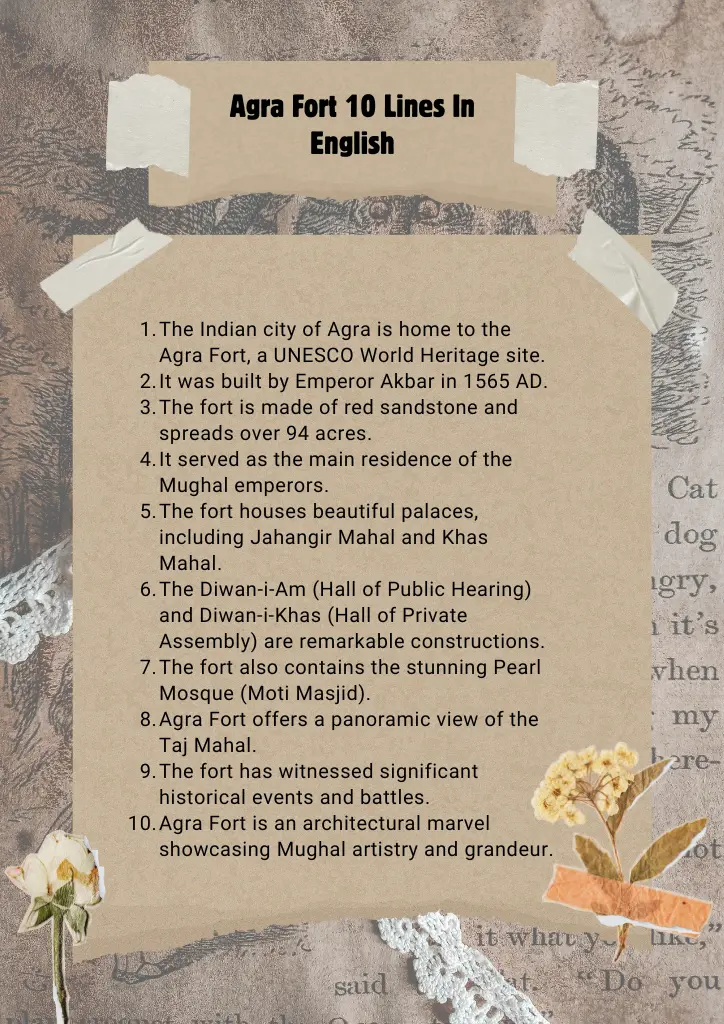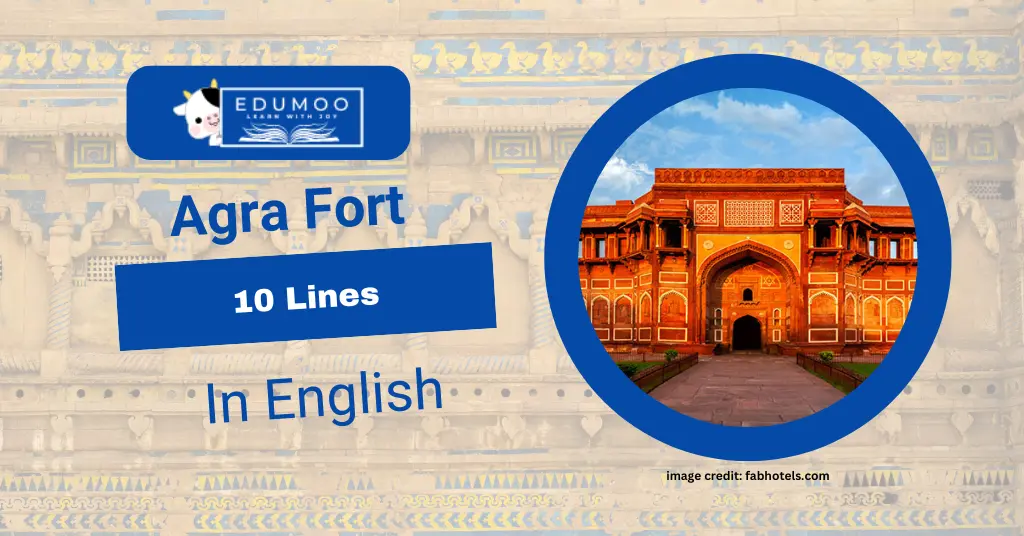Agra Fort, a UNESCO World Heritage site, is a stunning example of Mughal architecture and a significant historical landmark in India. This majestic fort, located in Agra, has witnessed centuries of history and power. In this article, we will explore the marvels of Agra Fort with Agra Fort 10 lines, highlighting its architectural splendour, historical significance, and unique features. From its massive red sandstone walls to its intricate palaces and mosques, Agra Fort stands as a testament to the grandeur of the Mughal era. Join us as we delve into the fascinating world of Agra Fort and uncover its timeless beauty and historical importance.
Agra Fort 10 Lines In English
- The Indian city of Agra is home to the Agra Fort, a UNESCO World Heritage site.
- It was built by Emperor Akbar in 1565 AD.
- The fort is made of red sandstone and spreads over 94 acres.
- It served as the main residence of the Mughal emperors.
- The fort houses beautiful palaces, including Jahangir Mahal and Khas Mahal.
- The Diwan-i-Am (Hall of Public Hearing) and Diwan-i-Khas (Hall of Private Assembly) are remarkable constructions.
- The fort also contains the stunning Pearl Mosque (Moti Masjid).
- Agra Fort offers a panoramic view of the Taj Mahal.
- The fort has witnessed significant historical events and battles.
- Agra Fort is an architectural marvel showcasing Mughal artistry and grandeur.

Essay On Agra Fort 10 Lines In English In 300 Words
Agra Fort, a UNESCO World Heritage site, is one of the most significant and impressive historical landmarks in India. Located in the city of Agra, this majestic fort stands as a testament to the grandeur of the Mughal Empire. Built by Emperor Akbar in 1565 AD, Agra Fort served as the main residence of the Mughal emperors until the capital was shifted to Delhi.
The fort is constructed of red sandstone and spreads over an area of 94 acres. Its massive walls, which stretch for 2.5 kilometres, enclose a rich history and a collection of magnificent buildings. The architecture of Agra Fort reflects a blend of Islamic and Hindu styles, showcasing the artistic and cultural achievements of the Mughal period.
Inside the fort, several beautiful palaces and structures captivate visitors with their intricate designs and historical significance. Jahangir Mahal, built by Akbar for his son Jahangir, is a notable example of Mughal architecture with its impressive facade and ornate interiors. Khas Mahal, another splendid palace, offers stunning views of the Yamuna River and the Taj Mahal.
Agra Fort also houses the Diwan-i-Am (Hall of Public Audience) and Diwan-i-Khas (Hall of Private Audience), where the emperor would address the public and dignitaries, respectively. The Pearl Mosque (Moti Masjid), located within the fort, is renowned for its pristine white marble and serene beauty.
One of the fort’s unique features is its strategic location, which offers a panoramic view of the Taj Mahal, adding to its historical and aesthetic value. Agra Fort has witnessed significant historical events, including battles and political intrigues, making it an important site for understanding India’s past.
In conclusion, Agra Fort is not only an architectural marvel but also a symbol of the rich cultural heritage of the Mughal era. Its impressive structures, intricate designs, and historical significance make it a must-visit destination for anyone interested in India’s history and architectural beauty.
Timeline of Agra Fort
- 1565: Agra Fort construction begins under Emperor Akbar.
- 1573: Red sandstone fortification completed.
- 1611-1618: Jahangir adds palaces like Jahangir Mahal.
- 1638: Mughal capital shifts to Delhi, reducing the fort’s importance.
- 1658-1707: Shah Jahan, under house arrest, dies in the fort.
- 1761: Marathas capture Agra Fort.
- 1803: British take control during Second Anglo-Maratha War.
- 1857: Fort briefly serves as a rebel stronghold during the Indian Rebellion.
- 1983: UNESCO designates Agra Fort a World Heritage site.
- Present: Agra Fort remains a major tourist attraction, showcasing Mughal architecture and history.
| Also Read: 10 Lines On Abdul Kalam In English |
Essay On Agra Fort 10 Lines In English In 700 Words
Agra Fort, a UNESCO World Heritage site, is one of the most significant and impressive historical landmarks in India. Located in the city of Agra, this majestic fort stands as a testament to the grandeur and architectural brilliance of the Mughal Empire. Built by Emperor Akbar in 1565 AD, Agra Fort served as the main residence of the Mughal emperors until the capital was shifted to Delhi. Its rich history, architectural splendour, and strategic importance make it a fascinating subject of study and admiration.
The fort is constructed of red sandstone and spreads over an area of 94 acres. Its massive walls stretch for 2.5 kilometres, enclosing a rich history and a collection of magnificent buildings. The architecture of Agra Fort reflects a blend of Islamic and Hindu styles, showcasing the artistic and cultural achievements of the Mughal period. This blend is particularly evident in the fort’s intricate carvings, delicate latticework, and grand facades.
Inside the fort, several beautiful palaces and structures captivate visitors with their intricate designs and historical significance. Jahangir Mahal, built by Akbar for his son Jahangir, is a notable example of Mughal architecture. The palace features an impressive facade with ornately carved decorations and spacious courtyards, reflecting the opulence of the Mughal court. Khas Mahal, another splendid palace within the fort, offers stunning views of the Yamuna River and the Taj Mahal. Its white marble construction and intricate decorations demonstrate the exquisite craftsmanship of the Mughal artisans.
Agra Fort also houses the Diwan-i-Am (Hall of Public Audience) and Diwan-i-Khas (Hall of Private Audience). The Diwan-i-Am was used by the emperor to address the public and listen to their grievances. This hall, with its open design and wide courtyards, reflects the emperor’s accessibility and concern for his subjects. In contrast, the Diwan-i-Khas was reserved for private meetings with dignitaries and important guests. The hall’s elegant architecture, featuring marble columns and intricate inlays, underscores the grandeur and exclusivity of the Mughal court.
The Pearl Mosque (Moti Masjid), located within the fort, is another architectural gem. Renowned for its pristine white marble and serene beauty, the mosque was built by Shah Jahan, the emperor who also commissioned the Taj Mahal. The Pearl Mosque’s simple yet elegant design provides a tranquil space for prayer and reflection, contrasting with the more elaborate structures within the fort.
One of the fort’s unique features is its strategic location, which offers a panoramic view of the Taj Mahal. This proximity to the Taj Mahal adds to the historical and aesthetic value of Agra Fort, linking two of India’s most iconic monuments. From the balconies of Khas Mahal and other vantage points within the fort, visitors can enjoy breathtaking views of the Taj Mahal, creating a visual and historical connection between these two masterpieces of Mughal architecture.
Agra Fort has witnessed significant historical events, including battles, political intrigues, and the rise and fall of empires. The fort played a crucial role in the Mughal Empire’s defense strategy, with its formidable walls and strategic location along the Yamuna River. Throughout its history, Agra Fort has been a center of power, influencing the course of Indian history. It was here that Emperor Shah Jahan was imprisoned by his son Aurangzeb, spending his final years gazing at the Taj Mahal, the mausoleum he built for his beloved wife, Mumtaz Mahal.
The fort’s rich history is also reflected in its many legends and stories, which continue to captivate visitors. Tales of royal intrigue, battles, and the lives of the Mughal emperors add depth and intrigue to the site, making a visit to Agra Fort a journey through time.
In conclusion, Agra Fort is not only an architectural marvel but also a symbol of the rich cultural heritage of the Mughal era. Its impressive structures, intricate designs, and historical significance make it a must-visit destination for anyone interested in India’s history and architectural beauty. The fort stands as a testament to the artistic and cultural achievements of the Mughal Empire, offering a glimpse into the opulent and complex world of the Mughal court. By preserving and studying Agra Fort, we can appreciate the rich tapestry of India’s past and the enduring legacy of one of its greatest empires. The grandeur of Agra Fort continues to inspire awe and admiration, reminding us of the timeless beauty and historical importance of this magnificent monument.
Conclusion
Agra Fort stands as a testament to the grandeur of the Mughal Empire, showcasing its architectural brilliance and historical significance. Today, we explored this UNESCO World Heritage site through detailed essays and Agra Fort 10 lines, unveiling its majestic palaces, serene mosques, and strategic viewpoints. From Jahangir Mahal to the Pearl Mosque, Agra Fort offers a glimpse into India’s opulent past. Preserving this marvel is crucial for appreciating the Mughal era’s cultural legacy. Let’s cherish and safeguard Agra Fort as a treasure trove of history, inspiring admiration for generations to come.

